|
|
 |
|
Calanoida ( Order ) |
|
|
|
Clausocalanoidea ( Superfamily ) |
|
|
|
Scolecitrichidae ( Family ) |
|
|
|
Scaphocalanus ( Genus ) |
|
|
| |
Scaphocalanus echinatus (Farran, 1905) (F,M) | |
| | | | | | | Syn.: | Scolecithrix echinata Farran, 1905 (p.37, Descr.F, figs.F); 1908 c (p.29); 1920 (p.18);
Amallophora echinata : Pearson, 1906 (p.18, Rem.);
Scolecithricella echinatus : Sewell, 1948 (p.570)
? Scaohocalanus brevicornis : Arcos, 1976 (p.85, Rem.: p.95, Table II, fig.F [non M]) [after C. Razouls] | | | | Ref.: | | | Farran, 1908 b (p.52, Rem.); Candeias, 1926 (1929) (p.34, figs.F); Farran, 1926 (p.258); 1929 (p.209, 250, fig.F); Rose, 1933 a (p.149, figs.F); Farran, 1936 a (p.98, Rem.); Mori, 1937 (1964) (p.50, figs.F); C.B. Wilson, 1950 (p.326, figs.F,M); Tanaka, 1961 a (p.181, figs.F,M); Grice, 1962 (p.213, figs.F, Rem.); Corral Estrada, 1970 (p.166, Rem., figs.F); Bradford, 1972 (p.44, figs.F); 1973 (p.143); Park, 1982 (p.77, 101, figs.F,M, Rem.); Chahsavar-Archad & Razouls, 1982 (p.28, fig.F); Gardner & Szabo, 1982 (p.286, figs.F,M); Bradford & al., 1983 (p.96, figs.F,M, Rem.); Campaner, 1984 (p.17, figs.F, Rem.); Chihara & Murano, 1997 (p.900, Pl.172: F,M); Bradford-Grieve & al., 1999 (p.881, 932, figs.F); Conway & al., 2003 (p.203, figs.F,M, Rem.); Vives & Shmeleva, 2007 (p.759, figs.F,M, Rem.) | 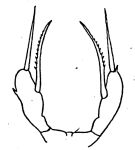 issued from : G.P. Farran in British Antarctic (\\\\\\\\\\\\\\\\\\\\\\\\\\\\\\\"Terra Nova\\\\\\\\\\\\\\\\\\\\\\\\\\\\\\\") Expedition, 1910. Natural History Reports. Zoology. Vol. VIII. Crustacea., 1929. [p.250, Fig.17]. Female: fifth feet.
|
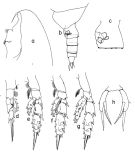 issued from T. Park in Biology of the Antarctic Seas XI, Antarct. Res. Ser, 1982, 34. [p.102, Fig.15]. Female: a, forehead (lateral); b, last part of thorax and urosome (lateral left side); c, genital segment; d, P1 (anterior); e, P2 (posterior); f, P3 (posterior); g, P4 (posterior); h, P5. Nota: Rostrum of 2 long filaments. Urosome about 24/100 length of prosome. The female shows some difference with the Farran's P5.
|
 issued from T. Park in Biology of the Antarctic Seas XI, Antarct. Res. Ser, 1982, 34. [p.103, Fig.16]. Male: a, habitus (lateral right side); b, last thoracic segment with P5 and urosome (right side); c, P1 (anterior); d, P3 (posterior); e, P5 (viewed from right side); f, distal part of left P5. Nota: Urosome about half the length of prosome.
|
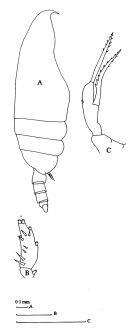 issued from : J.M. Bradford, L. Haakonssen & J.B. Jillett in Mem. N.Z. Oceanogr. Inst., 1983, 90. [p.98, Fig.57]. Female: A, habitus (lateral right side); B, endopod of P2; C, P5. Nota: The south-west Pacific specimens appear to be some variation in the number of spinules on the posterior surface of the endopod of P2 and the length of the inner edge spine on female P5.
|
 issued from : A.F. Campaner in Bolm. Zool., Univ. S. Paulo, 1984, 6 . [p.1168, Fig.2 e-j]. Female (from off Rio de Janeiro): e, rostrum (lateral); f, genital somite (lateral right side); ; g, exopodal segments 2 and 3 of P1 (posterior); h, P5 (specimen of 1.75 mm); i, P5 (specimen of 1.85 mm); j, P5 (specimen of 2.19 mm.
|
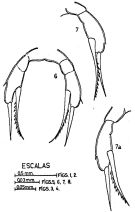 issued from : J. Corral Estrada in Tesis Doct., Univ. Madrid, A-129, Sec. Biologicas, 1970. [Lam.46, figs.6-7]. Female (from Canarias Is.): P5; 7, 7a, P5 (other individuals).
|
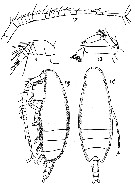 issued from : G.P. Farran in Ann. Rep. Fish. Brch., Ireland, 1902-1903, II, App. 2, 1905. [Plate IV, Figs.15-18]. As Scolecithrix echinata. Female (from W ireland): 15-16, habitus (lateral and dorsal, respectively); 17, A1; 18, A2.
|
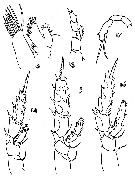 issued from : G.P. Farran in Ann. Rep. Fish. Brch., Ireland, 1902-1903, II, App. 2, 1905. [Plate V, Figs.12-17]. As Scolecithrix echinata. Female: 12, Mx1; 13-17, P1 to P5.
|
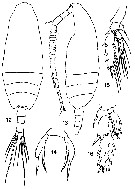 issued from : T. Mori in The pelagic Copepoda from the neighbouring waters of Japan, 1937 (2nd edit., 1964). [Pl.24, Figs.12-16]. Female: 12-13, habitus (dorsal and lateral, respectively); 14, P5; 15, P4; 16, P2.
|
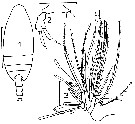 issued from : J.M. Bradford in Mem. N. Z. Oceonogr. Inst., 1972, 54. [p.43, Fig.10, (1-3)]. Female (from Kaikoura, New Zealand): 1, habitus (dorsal); 2, P5; 3, Mx2.
|
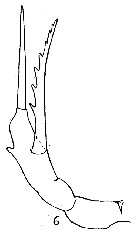 issued from : G.P. Farran in Fish. Ire. Sci. Invest., 1906, II [1908]. [Pl. VI, Fig.6]. As Scolecithrix echinata. Female (from W Ireland): 6, P5.
|
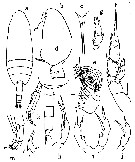 issued from : O. Tanaka em>in Publ. Seto Mar. Biol. Lab., 1961, IX (1). [p.182, Fig.123]. Female (from Japan: Izu Region): a, habitus (dorsal); b, forehead (lateral); c, rostrum (frontal view); d, last thoracic segment and genital segment (lateral, left side); e, Mx2; f, P2; g, endopod of P3; h, P5; i-j, P5 (different specimens). - Cephalothorax and abdomen in proportional lengths 79 : 21. - The last two thoracic segments incompletely separatd. ; lateral corner rounded. - Rostral filaments long and slender. - Urosomal segments and caudal rami in proportional lengths 32 : 21 : 20 : 10 : 17 = 100. - Caudal rami 2 times as long as wide. - Genital segment as long as wide, produced slightly below. - Exopod of A2 about 1.4 times as long as the endopod. - Exopod of Md about as long as the endopod. - Mx2 with 3 long vermiform and 5 bud-like filaments on the distal segment ; setae on the 4th and 5th lobes are slender. - Basipod 1 and 2 of Mxp of about equal lengths ; 1st segment with a bud-like sensory filament on the anterior margin about the middle of the segment. - Terminal spine of exopod of P2 with 20 teeth. - P5 with the inner marginal spine about 1.5 times as long as the terminal one, and furnished with about 9 teeth on the outer margin. - P5 variable in structure ; some specimen with a rudimentary endopod, and the terminal spine is much shorter than the segment itself. Male: k, last thoracic segment and urosome (lateral); l, 1st segment of exopod of P2; m, distal segments of P5. - Cephalothorax and urosome in proportional lengths 72 : 28. - Urosomal segments and caudal rami in proportional lengths 14 : 23 : 21 : 28 : 3 : 11 = 100. A1 20-segmented (segments 8-12 fused, 24-25 fused) on the left side; 19-segmentedon the right side. - Terminal spine of exopod of P2 with 40 teeth. - P5 reaches back to the distal end of the 4th urosomal segment. Exopod of the right leg 3-segmented, but the distal segment is very small an is represented by a slender process ; endopod 1-segmented on the left.
|
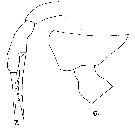 issued from : G.D. Grice in Fish. Bull. Fish and Wildl. Ser., 1962, 61. [p.212, Pl.19, Figs.6-7]. Female (from 01°10'S, 134°57'W): 6, posterior part of thorax and genital segment (lateral, left side); 7, P5.
|
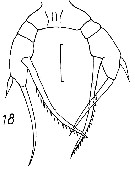 issued from : D.F. Arcos in Rev. Com. perm. Pacifico Sur, 1976, 5. [Fig. 18]. As Scaphocalanus brevicornis. 18: P5 female [non male] (from 53°07.5 S, 73°08.1 W). Scale bar = 50µ. Nota: in deep water (0-600 m), temperature 5.12 to 8.48°C and salinity from 28.62 to 33.28 p.1000.
|
 issued from : O. Tanaka in Publ. Seto Mar. Biol. Lab., 1961, IX (1). [p.183]. Male: Proportional lengths of the segments of A1.
|
 Issued from : M. Sano, K. Maki, Y. Nishibe, T. Nagata & S. Nishida in Progr. Oceanogr., 2013, 110. [p.19, Figs. 8, 9]. Second maxilla (Mx2) and maxilipeds from Scaphocalanus echinatus (e), Scottocalanus helenae (f) and Scottocalanus securifrons (g). Scale bars: Mx2 = 100 µm (e, f); 200 µm (g); Mxp = 100 µm (e); 200 µm (f, g). The setae of the second maxillae in Sco. securifrons, Sco. helenae, and Sco. echinatus are similar in shape to specialized chemosensory setae; among these, the setae in Sca. echinatus are relatively fine. The maxilipeds of Sco.helenae and Sco. securifrons have short, stout setae, Sca. echinatus have fine plumose setae (as in Calanus sinicus. The feeding appendages (Mx2 and Mxp) appear suitable for feeding on fine particulate organic material contrary of Scottocalanus helenae and Scottocalanus securifrons. Compare figures of setal armament from three species in the two genera).
| | | | | Compl. Ref.: | | | Hardy & Gunther, 1935 (1936) (p.165, Rem.); Sewell, 1948 (p.349, 502, 514, 546, 549); Ahlstrom & Thrailkill, 1963 (p.57, Table 5, abundance); Unterüberbacher, 1964 (p.24); Furuhashi, 1966 a (p.295, vertical distribution in Oyashio/Kuroshio transitional area, Table 7, 9, 10); Grice & Hulsemann, 1965 (p.224); 1967 (p.16); Fleminger, 1967 a (tabl.1); Park, 1970 (p.476); Shih & al., 1971 (p.152); Roe, 1972 (p.277, tabl.1, tabl.2); 1972 b (p.536); Björnberg, 1973 (p.331, 389); Corral Estrada & Pereiro Muñoz, 1974 (tab.I); Vives & al., 1975 (p.43, tab.II, IV, XII); Deevey & Brooks, 1977 (p.256, tab.2, Station "S"); Carter, 1977 (1978) (p.35); Dessier, 1979 (p.205); Pipe & Coombs, 1980 (p.223, vertical occurrence); Vives, 1982 (p.292); Kovalev & Shmeleva, 1982 (p.84); De Decker, 1984 (p.316); Brenning, 1984 (p.4, Rem.); Guangshan & Honglin, 1984 (p.118, tab. as echinata); Greze & al., 1985 (p.7); Brenning, 1985 a (p.28, Table 2); Brinton & al., 1986 (p.228, Table 1); Rudyakov, 1986 (tab.1); Lozano Soldevilla & al., 1988 (p.59); Madhupratap & Haridas, 1990 (p.305, fig.6: vertical distribution night/day; fig.7: cluster); Hattori, 1991 (tab.1, Appendix); Gopalakrishnan & Balachandran, 1992 (p.167, figs.1, 3, Table 1, 2); Shih & Young, 1995 (p.73); Gopalakrishnan & Saraledevi, 1998 (p.132, fig.6, chart); .Suarez-Morales & Gasca, 1998 a (p.111); Lapernat, 2000 (tabl. 3, 4); Razouls & al., 2000 (p.343, Appendix); Lopez-Salgado & al., 2000 (tab.1); Holmes, 2001 (p.58); Sameoto & al., 2002 (p.13); Beaugrand & al., 2002 (p.179, figs.5, 6); Lo & al., 2004 (p.89, tab.1); Shimode & al., 2005 (p.113 + poster); Kuriyama & Nishida, 2006 (p.300: Tab.II; p.309: Tab.III, fig.7, 10, vertical distribution); Valdés & al., 2007 (p.104: tab.1); Fernandes, 2008 (p.465, Tabl.2); Tseng L.-C. & al., 2008 (p.153, Table 2, occurrence vs geographic distribution); Ayon & al., 2008 (p.238, Table 4: Peruvian samples); Galbraith, 2009 (pers. comm.); Park & Ferrari, 2009 (p.143, Table 5, 7: common deep water species, fig.1, Appendix 1, biogeography); Hidalgo & al., 2010 (p.2089, Table 2); Dias & al., 2010 (p.230, Table 1); Medellin-Mora & Navas S., 2010 (p.265, Tab. 2); Tutasi & al., 2011 (p.791, Table 2, abundance); Pillai H.U.K. & al., 2011 (p.239, Table 3, vertical distribution); in CalCOFI regional list (MDO, Nov. 2013; M. Ohman, comm. pers.); Hirai & al., 2013 (p.1, Table I, molecular marker); Sano & al., 2013 (p.11, Table 2, 5, A1, figs.5, 8, 9, feeding habits, vertical distribution); Lidvanov & al., 2013 (p.290, Table 2, % composition); Bonecker & a., 2014 (p.445, Table II: frequency, horizontal & vertical distributions); El Arraj & al., 2017 (p.272, table 2, seasonal composition); Dias & al., 2019 (p.1, Table II, IV, occurrrence, vertical distribution). | | | | NZ: | 20 | | |
|
Distribution map of Scaphocalanus echinatus by geographical zones
|
| | | | | | | | | | | | | | | 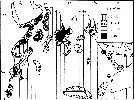 issued from : Gopalakrishnan & Saraledevi in Pelagic Biogeography ICoPB II. Proceedings of the 2nd International Conference. Final report of SCOR/IOC working group 93. Noordwijkerhout, The Netherlands 9-14 July 1995. Workshop Report No.142. UNESCO, 1998. [p.133, Fig.6]. issued from : Gopalakrishnan & Saraledevi in Pelagic Biogeography ICoPB II. Proceedings of the 2nd International Conference. Final report of SCOR/IOC working group 93. Noordwijkerhout, The Netherlands 9-14 July 1995. Workshop Report No.142. UNESCO, 1998. [p.133, Fig.6].
Distribution and abundance in number of specimens/standard haul of Scaphocalanus echinatus in the Indian Ocean. |
 Issued from : M. Sano, K. Maki, Y. Nishibe, T. Nagata & S. Nishida in Progr. Oceanogr., 2013, 110. [p.20, Fig.10]. Issued from : M. Sano, K. Maki, Y. Nishibe, T. Nagata & S. Nishida in Progr. Oceanogr., 2013, 110. [p.20, Fig.10].
Vertical distribution of eight copepod species across 0-1000 m in Sagami bay in 21-27 April 2009.
White and black boxes denote daytime and nighttime distributions. Scaphocalanus echinatus/em> is taken from Kuriyama & Nishida (2006).
Plankton and water samples collected from a fixed station (35°00'N, 139°20'E) using MTD horizontal closing nets (0.33 mm mesh aperture) at 15 depths (0, 50, 95, 100, 150, 195, 200, 295, 300, 395, 400, 500, 600, 800, 1000 m) during both day and night.
Atomic ratio C;N (mean ±SD) = 6.8 ±0.3, n = 3. |
 Issued from : M. Madhupratap & P. Haridas in J. Plankton Res., 12 (2). [p.313, Fig.6]. Issued from : M. Madhupratap & P. Haridas in J. Plankton Res., 12 (2). [p.313, Fig.6].
Vertical distribution of calanoid copepod (mean +1 SE), abundance No/100 m3. 55- Scaphocalanus echinatus.
Night: shaded, day: unshaded.
Samples collected from 6 stations located off Cochin (India), SE Arabian Sea, November 1983, with a Multiple Closing Plankton Net (mesh aperture 300 µm), in vertical hauls at 4 depth intervalls (0-200, 200-400, 400-600, 600-1000 m). |
| | | | Loc: | | | Antarct. (SW Atlant., Pacif.), ? Magallane region (in Arcos, 1976), South Georgia, sub-Antarct. (SW Atlant., Indian, SW & SE Pacif.), South Africa (S & W), Namibia, Congo, off NW Cape Verde Is., off Morocco-Mauritania, Canary Is., off Madeira, Brazil, off Rio de Janeiro, The Campos Basin, , off Macaé, off Amazon, Caribbean Sea, Caribbean Colombia, G. of Mexico, Florida, off Bermuda: Station ‘’ S’’ (32°10’N, 64°30’W), Sargasso Sea, off E Nova Scotia, Portugal, Bay of Biscay, off W Ireland, Wyville Thomson Ridge, Ibero-moroccan Bay, W Medit. (Alboran Sea), Natal, Madagascar (Nosy Bé), SW Indian, Bay of Bengal, Andaman Sea (Batten Island), Philippines, China Seas (East China Sea, South China Sea), Taiwan, Mienhua Canyon, Japan, Sagami Bay, off Sanriku, Pacif. (W equatorial), Australia (Great Barrier), New Zealand (Kaikoura), off Queen Charlotte Is., Strait of Georgia, California, W Baja California, Gulf of California, Pacif. (equatorial), Hawaii, Galapagos-Ecuador, Peru, Chile (N-S). | | | | N: | 87 | | | | Lg.: | | | (9) F: 2,3-1,55; (34) F: 1,8; (35) F: 2,3-2,28 [Antarct.]; F: 1,8 [off N-Z]; (38) F: 2,4-1,8; (58) F: 1,92; (76) F: 2,56-2,16; M: 2,36-2,12; (101) F: 2; (108) F: 2,48-1,84; M: 1,34-1,26; (116) F: 2,4; (137) F: 2,4-2; M: 1,8; (180) F: 1,74; 1,72; (199) F: 2,43-1,75; (412) F: 2; (432) F: 2,3-2,15; (991) F: 2,16-2,56; M: 2,12-2,36; (1000) F: 2,3 ± 0,2; M: 1,9 ± 0,1; (1111) F: 1,92-2,4; {F: 1,55-2,56; M: 1,26-2,36} | | | | Rem.: | epi-meso-bathypelagic.
Sampling depth (Antarct., sub-Antarct.) : 100-1000 m. Sargasso Sea: 500-1000 m (Deevey & Brooks, 1977, station "S"). 360-400 m (Pipe & Coombs, 1980 at 60°N, 07°W).
Distributional range (m) from Roe (1972) Day: 150-950, Night: 50-960; from Grice & Hulsemann (1965): 200-1000 (in Kuriyama & Nishida, 2006).
This species resembles S. longifurca but the inner edge setae on the P5 are coarsely toothed.
Sano & al. (2013, p.23) note that the genus is considerd omnivore/detritivore in previous studies, and their chemo-sensory setae are considered to be involved in the detection of detritus (marine snow) (see in Nishida & Ohtsuka, 1997).
See in DVP Conway & al., 2003 (version 1) | | | Last update : 25/10/2022 | |
|
|
 Any use of this site for a publication will be mentioned with the following reference : Any use of this site for a publication will be mentioned with the following reference :
Razouls C., Desreumaux N., Kouwenberg J. and de Bovée F., 2005-2025. - Biodiversity of Marine Planktonic Copepods (morphology, geographical distribution and biological data). Sorbonne University, CNRS. Available at http://copepodes.obs-banyuls.fr/en [Accessed December 03, 2025] © copyright 2005-2025 Sorbonne University, CNRS
|
|
 |
 |



















